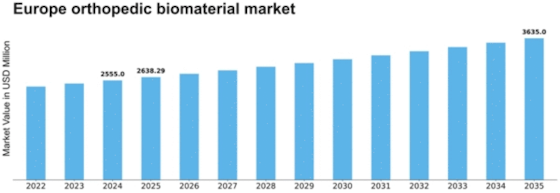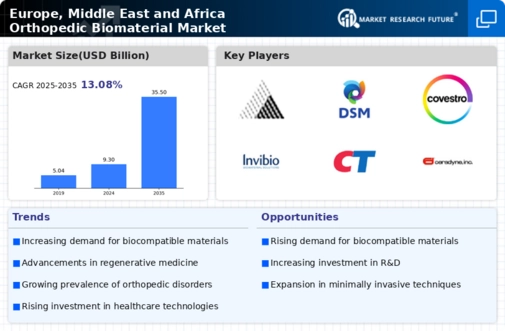Europe Orthopedic Biomaterial Size
Europe Orthopedic Biomaterial Market Growth Projections and Opportunities
The Europe, the Middle East, and Africa (EMEA) Orthopedic Biomaterial Market are strongly influenced by the aging population in these regions. As the elderly demographic increases, so does the prevalence of orthopedic conditions, creating a significant demand for biomaterials used in orthopedic implants and devices. Technological innovations in biomaterials propel the EMEA Orthopedic Biomaterial Market. The advancements in materials science like biocompatible polymers, ceramic and enhanced metals lead to the creation of better performing durable as well as biological friendly Biomaterials. Increasing cases of orthopedic disorders including osteoarthritis and fractures drives the demand for orthopedic biomaterials. Biomaterials occupy a significant place in the manufacture of implants for joint replacement, spinal surgeries and fractures fixation to meet increasing demand for health care service. The regenerative medicine concepts are gaining popularity in the orthopedic field and influence biomaterials adoption. Biomaterials that have the ability to regenerate including tissue engineered scaffolds are supporting repair and regeneration of damaged tissues in addition, thus contributing to market growth. Orthopedic issues are also related to lifestyle factors such as sedentary behavior and obesity. The EMEA region records a growing consciousness of the use role played by biomaterials in countering these challenges, and as such, an increased need for orthopedic biomaterial products. Sports-related injuries, specifically in areas with strong sports culture have an effect to the Orthopedic Biomaterial Market. Biomaterials play an integral role in the manufacture of orthopedic implants and devices used to treat sports-related injuries, which affect market dynamics. Innovations in minimally invasive surgery add to the need for customized orthopedic biomaterials. Biomaterials suitable for minimally invasive procedures have become the preferred option due to their efficacy in reducing recovery time and enhancing patient outcomes. Government aided programs and investments to improve healthcare infrastructure aid the market growth. Healthcare services are the key point of concern for governments in the EMEA region, orthopedic biomaterials serve as a pillar towards enhanced quality of life care. The Orthopedic Biomaterial Market, product innovations result from R&D activities in collaboration with academic institutions and industry players. Work towards the advancement of new biomaterial with improved characteristics and functionalities impact market activities. Orthopedic tourists are attracted to EMEA region where they seek specialized orthopaedics procedures. The increasing popularity of medical tourism further drives the demand for quality orthopedic biomaterials as patients require modern procedures and implants in these areas. Market forces are also influenced by economic considerations and cost containment in healthcare systems. Although there is a need for complex orthopedic biomaterials, the companies may also aim at developing low cost solutions to circumvent budgetary constraints in heath c care settings. The ongoing impact of the COVID-19 pandemic has affected elective surgeries and orthopedic procedures. However, the gradual recovery of healthcare services and the need for orthopedic interventions contribute to the resilient nature of the Orthopedic Biomaterial Market in the EMEA region.


















Leave a Comment